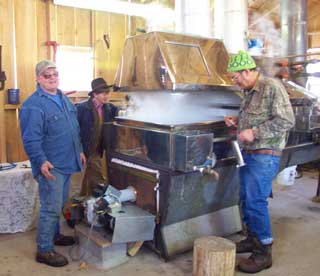
Maple Sunday "The family that saps together sticks together," Sandy Shay, of Maple Grove Farm joked. Shay is the sister of husband and wife team, Jim and Deb Day, who own and operate the fifth generation family farm in Holley, and she is a frequent helper during the tapping season, as is Jim and Deb's son, Bob. Lee Bartlett, Deb and Sandy's father, is the master sugar maker of the operation. "This is my dad's homestead," Deb Day said. "My great-great-great grandfather, John Barlett, first lived here." Barlett purchased the farm from the Connecticut Land Company in the mid 1800s and the first sugarhouse was built. There have been a couple of sugarhouses constructed on the property with the most recent being built in 1996. Day said the sugaring process was stopped for a while. "I was a stay at home mom and decided to start making syrup again," she said. "I started out with small metal pans and it took me three, 12-hour days to make one gallon of syrup." Her father, Lee Bartlett, brought her larger metal pans and then the family made their way back into running the syrup as a full-fledged operation. "We tap about 550 trees a season," she said. "This year we're hoping to get at least a quart of syrup per tap." "Back in the good old days," Bartlett said, "our sugar house consisted of a canvas covered lean-to ... we didn't get many visitors back then." Day said her husband was the driving force behind getting the maple sugar operation running again. It takes about 40 gallons of sap to make one gallon of syrup, the Days explained. They tap trees that are 35-40 years old and are 10 inches in diameter. The trees are tapped with plastic spiles after the holes are drilled. "The trees heal each year," Deb Day said. The "sugaring off" season happens only in the spring when the days are warm and the nights are freezing - normally late February through early April. The grove of sugar maple trees that are connected with a network of plastic tubes to collect the sap are called the sugar bush, Day explained. The sap flows from the trees into a collection tank and is then piped to the sugarhouse for the evaporation process. "The sap is two percent sugar when it comes from the trees ... it is odorless, colorless and only slightly sweet," Deb Day explains. "Once it becomes maple syrup, it's about 67 percent sugar." While the traditions of gathering the sap may have changed, the love of the craft hasn't. Deb Day said, "It's definitely a labor of love and it really keeps our family together." Maple Grove Farm, located at 4394 South Holley Road off of Route 31A in Clarendon, offers tours during the maple season and scheduled group tours. In their sugarhouse, various maple products are offered for sale including pure maple syrup, candies, granulated sugar and maple cream. The cream is the consistency of peanut butter and has a smooth, rich flavor that can be spread on toast, crackers ... or even eaten by the spoonful. All of the products are pure maple syrup with no additives. Visitors to the farm and the sugar shack will come upon a hollowed out log poised beneath a wooden tap. Deb Day says the log and tap are part of the legend and lore of the beginnings of maple sugaring. The story goes that a little Indian boy was asked by his mother to go to the river and get some water for dinner, but he got involved in playing and forgot, Day said. So on his way home he scooped water out of a hollow log and after his mother boiled the meat in the water it came out with a sweet flavor and she asked where the water came from. The boy took his mother to the hollow log and they saw sap dripping from a sugar maple tree into the log and that, according to the legend, was the beginning of sugaring. Day said the Indians dropped hot rocks into the logs to evaporate the sap and turn it into syrup. The eighth annual Maple Weekend will be celebrated March 22 and 23 from 10 a.m. to 4 p.m. both days and this will be the first year Maple Grove Farm has participated. Flyway Farm in Medina has participated for several years, Deb Days said. Maple Grove Farm will be offering tours and maple products for sale. The event will be held regardless of the weather but Deb Day urges visitors to wear their boots. Call Maple Grove Farm at 638-6245 to make certain someone is at the sugarhouse if you are planning a visit on a day other than Maple Weekend. Freezing weather delays syrup production somewhat Ideal conditions for tapping are freezing temperatures at night and just above freezing temperatures during the day (32-45°). This creates a differential in the pressure of the tree to encourage sap flow. Typically, the tree will generate 12 psi to encourage sap flow. Excellent subsoil moisture will help ensure an adequate supply of soil moisture for sap production as well as a differential in pressure as caused by the temperature swings, King stated in a press release. |
